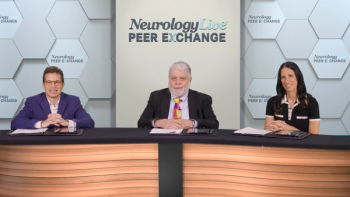
Setting the Stage of S1Ps With Fingolimod
In this episode, Patricia Coyle, MD, FAAN, provides in-depth insight on fingolimod, the first approved S1P receptor modulator, and the clinical data pre- and post-approval.
Episodes in this series
Over the years, the multiple sclerosis (MS) neurotherapeutic landscape has rapidly evolved, with new disease-modifying treatments of various novel mechanisms that have improved efficacy and safety. It has been thought that a more tailored approach to treatment will allow for better personalization of drug selection for patients. Sphingosine 1-phosphate (S1P) receptor modulators, one of the newer drug classes, have emerged as a disease-modifying option for MS that has a unique mechanism of action compared with other therapies.
To date, 4 S1P receptor modulators: fingolimod (Gilenya; Novartis), ozanimod (Zeposia; BMS), ponesimod (Ponvory; Janssen), and Siponimod (Mayzent; Novartis), are approved by the FDA and the European Medicines Agency for the treatment of MS. Fingolimod, a nonselective S1P receptor modulator targeting S1P1, S1P3, S1P4, and S1P5, was the first approved therapy in this class, dating back to 2010. This class of medications function by blocking the lymphocytes to egress from lymph notes, leading to a reduction in the number of lymphocytes in the peripheral blood.
As part of a new series, neurologists
In this segment, Coyle, a professor of neurology at Stony Brook Medicine, gave a clinical overview of fingolimod, its administration, and the evidence that supports its treatment effects, particularly in pediatric MS. She covered the safety risks with the therapy, as well as its potential for disease activity rebound. In addition, she provided more detail on the advantages of this agent and some of the future research the clinical community is interested in.
Transcript edited for clarity.
Patricia Coyle, MD, FAAN: Let's start with the parent compound, the first-generation S1P receptor modulator, fingolimod. Fingolimod is given at 0.5 milligrams daily, once a day, taken by mouth. However, when starting fingolimod, you need to undergo a six-hour observation period. This is because there's a slight chance of developing bradycardia or even heart block, which necessitates monitoring. During this period, an EKG is done at the beginning and end, and hourly vital signs are taken. This concern about cardiac side effects, particularly with S1P receptor 3, was a driving force behind the development of second-generation S1P receptors that may avoid targeting S1P receptor 3. Fingolimod hits S1P receptors 1, 3, 4, and 5, hence the need for the six-hour observation period, but once that’s done, you're in the clear.
Fingolimod is particularly interesting because it showed extraordinarily positive results in pediatric MS trials, specifically in the PARADIGMS trial. In this trial, pediatric MS patients were randomized to fingolimod or IM interferon beta-1a, and the fingolimod arm performed fantastically well. As a result, fingolimod is approved for use in patients as young as 10, with a smaller dose of 0.25 milligrams for those weighing less than 40 kilograms. While it's likely that other S1P receptor modulators would work in pediatric MS, they haven’t been tested yet, so fingolimod stands out with its positive Phase 3 trial results in this population.
Fingolimod also underwent a Phase 3 trial for Primary Progressive MS. The S1P receptors all penetrate the central nervous system, affecting the big cells there, so there was hope for positive effects within the central nervous system. Unfortunately, the trial was a bust; fingolimod showed no benefit in Primary Progressive MS, which was a great disappointment. None of the other medications, including siponimod, which was tested in Secondary Progressive MS, have been checked in Primary Progressive MS.
The half-life of fingolimod is about six to nine days, so it takes a couple of weeks to wash out. It's also an immunosuppressive agent, so there are risks, such as herpes infections, cryptococcal fungal infections, and there have been dozens of PML (progressive multifocal leukoencephalopathy) cases. Patients should be counseled about the risk of PML when using fingolimod. Fingolimod was tested against placebo and also against IM interferon beta-1a, and it performed better than that active comparator, making it a strong option despite some issues.
One significant concern with fingolimod is the need for the six-hour cardiac evaluation when starting the drug, as well as monitoring for infections. Additionally, a minority of patients may experience rebound. Rebound occurs when, after stopping fingolimod and it’s out of the system in six to eight weeks, there's a chance of increased MS disease activity for a short period before it subsides. This is why, when removing fingolimod, it's essential to quickly implement a new disease-modifying therapy to control the MS damage process and avoid this rebound concern. One of the big questions with the S1P receptor modulators as a family is whether the second-generation S1P receptors have the same rebound problem as fingolimod, and we haven't fully answered that yet.
Newsletter
Keep your finger on the pulse of neurology—subscribe to NeurologyLive for expert interviews, new data, and breakthrough treatment updates.








































